|
Some readers of this review will be well aware of my affinity for fountain
pens which have been dedicated to the memory of historic astronomers,
which comes about because of my professional and personal research interests
in the history of astronomy. Fortunately for me, a number of limited and
special edition pens have been marketed with this focus over the past
few years, primarily by Italian companies. One such company is Stipula,
of the city of Firenze (Florence). Stipula is a relatively young company;
it only began to use the trade name Stipula in 1995, after making pens
in its own name since just 1982. Acquired by Etruria in 2005, this family-owned
firm only has around ten employees, which is remarkable when you consider
the hand work involved in the lathe-turned range of regular and limited
edition pens they produce.
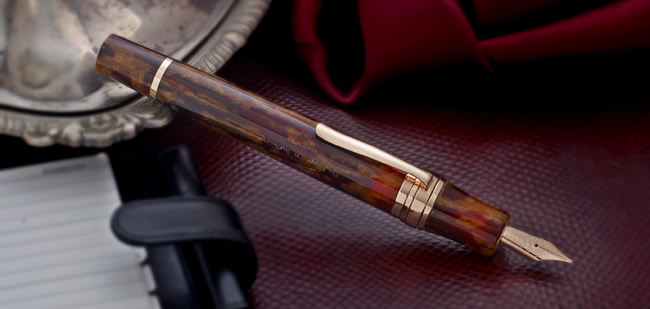
The Infinity is a substantial
but elegant pen, and would grace any desk, especially that of a scientist,
engineer, historian or artist.
Having recently been looking at the astronomical activities of Leonardo
Da Vinci (1452-1519), the world-famous Italian artist, engineer and scientist
for an article I was writing for Popular Astronomy magazine, I was inspired
to seek out pens named for him. This led me to a 2005 Stylophiles Online
Magazine review of the Stipula Da Vinci Infinity fountain pen, a weird
and wonderful device which at the time was available exclusively via Bertram’s
Inkwell of Baltimore, USA.
Of course, the Da Vinci design is not unique to the Infinity LE; in fact
it is available at lower prices in several different materials and colours,
and in two sizes with different clip designs. But the version I fell in
love with at first sight was the Infinity, thanks to the fascinating Stylophiles
review and Bill Riepl’s alluring photographs of the pen therein.
I knew I had to buy one, but what chance was there of finding a new pen
from a limited edition of only 188 which had already been available for
two years?
A look at the Bertram’s Inkwell website (www.bertramsinkwell.com)
revealed that they were apparently no longer stocking this pen. I was
immediately disappointed, but a subsequent search on Google came up with
a website I had glanced over before, but from which I had never purchased
a pen: Fountain Pen Domain (www.penseller.com). As luck would have it,
they were advertising the Da Vinci Infinity – and at a reasonable
price: the list price was $800 US but Fountain Pen Domain’s price
was significantly lower at $539 US plus shipping. A glance at eBay showed
just one such pen for sale, used, at a similar price, so it was obvious
that the discounted new price was a good deal.
A Google search to check the reputation of Fountain Pen Domain revealed
that its proprietor, Weaver McCracken, was (according to past customers)
a reliable seller, and this was to be my experience in my subsequent dealings
with Weaver, who was very helpful and a pleasure to deal with. Yes, he
could supply this pen, and he advised that it would be quicker and cheaper
for him to ask Stipula to ship direct from the factory in Italy to me
in England rather than for him to get one in stock and send it me from
the USA. This made a lot of sense as both Italy and the UK are in the
European Union. Including manufacturing time it took a little over three
weeks for the Infinity to get to me once I had paid by PayPal.
When I opened the box, it was obvious from the point of view of looks
at least that I had made the right choice. The Stipula Da Vinci Infinity
is a vision in warm amber celluloid and rose gold-plated metalwork, including
the 14k gold nib, which is also plated in rose gold, my favourite colour
of this precious metal. In fact when seeing the pen ‘in the flesh’
it was evident that Bill Riepl’s fine photographs for Stylophiles
did the Infinity full justice, and when I decided to write this review
I asked Bill’s permission to use a selection of his pictures to
accompany my text, to which he kindly agreed (thanks, Bill!).
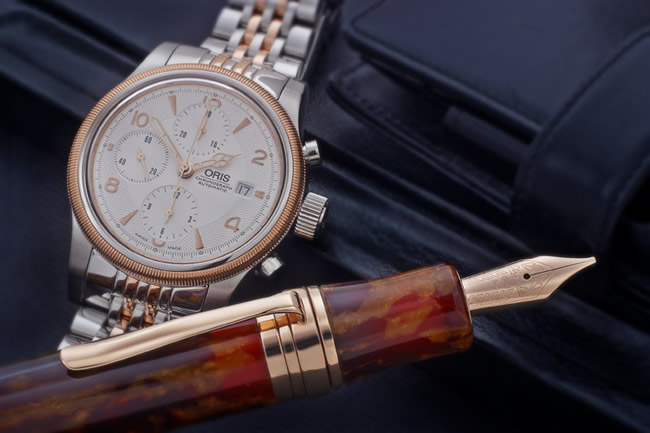
The Stipula Da Vinci Infinity
LE is truly a writing instrument, akin to a high quality watch in its
ingenuity and fascination.
The Stipula box is plain but attractive, in red leatherette covered board
with gold coloured lettering (the Stipula logo) on the padded top and
comes wrapped in a protective sleeve of red card with an aperture to show
off the logo. Inside, the pen is laid beneath a strap upon a beige coloured
‘velvety’ padded bed. On opening the box a ‘secret’
drawer is also revealed in its base; the right hand side folds down and
the drawer pulls out with a handle of looped red ribbon. Within there
is a generic Stipula instructions/warranty booklet covering various pens,
and a certificate of authenticity and lifetime warranty registration form.
A standard Stipula ink piston converter is supplied, plus a short International
cartridge of blue ink, together in a sealed bag.
The Infinity Limited Edition version of the Stipula Da Vinci is a stunning
looking pen, albeit of unconventional design. The highly polished variegated
amber celluloid of the barrel and section glows darkly, like the embers
of a dying fire, and it is superbly complemented by the warm rose gold-plated
fittings, which comprise a single trim ring towards the end of the barrel,
the artfully curved rotating clip, the hefty collar to which this is mounted,
and the end cap which hides the Da Vinci’s secret. The barrel is
engraved clearly but unobtrusively with the Stipula brand, the name and
number of the pen, and the country of origin. The whole instrument (and
yes, this is truly a writing instrument in the best sense of the word)
feels delightful in the hand: smooth, warm, heavy, and balanced towards
the section. I find it hard to put down once picked up, it feels so good.
In size, the retracted Infinity is the same length as a capped Duofold
Centennial (5.25 inches), but somewhat thicker overall (it is widest at
the clip and tapers gently to the end of the barrel, the section being
scalloped for ease of holding). Personally, I have average sized hands
and it feels perfect to me, but very different to my other pens. Likewise,
it may be that if you have very small hands you might prefer a thinner
section and barrel. However the weight, while supremely well-balanced,
is substantial, due to the stainless steel mechanism and other sleeving
within the pen, and this might not suit those who prefer lightweight pens.
The weight of the Infinity when loaded with converter and ink is 70g (2.4oz).
My Conway Stewart Churchill lever-filler in red woodgrain ebonite, without
ink and no small pen itself, weighs in at just 32g in comparison! My Parker
Duofold Greenwich, a Centennial sized pen in black resin, is a mere 28g
with inked converter.
The Da Vinci pens are based around a singularly ingenious mechanism which
obviates the need for a separate cap. The nib is retractable, and hides
behind a rotating metal ‘trap door’ until needed. Looking
from the nib end, as you rotate the main body of the barrel counter-clockwise
while holding the section, a small semi-circular door rotates open clockwise,
and the nib emerges smoothly from the shadows in mysterious fashion. The
extended nib is the standard large Stipula nib, in 14K gold, in this case
plated in rose gold as previously mentioned. Inside the barrel the enclosed
working parts are stainless steel, extending from the section. The whole
mechanism and modus operandi are quite fascinating, and a great talking
point amongst friends and colleagues who rarely see a fountain pen, let
alone such an arcane device as this! Together with the construction materials,
this gives the pen great character, and I am sure if Leonardo were still
alive today he would fully approve of its ingenuity.

The remarkably effective rose
gold-plated ‘trapdoor’mechanism, showing the nib ‘launch
sequence’!
How does the Infinity fill? Either by cartridge – standard International,
short or long (ie Diamine,Waterman etc) or by using the supplied standard
Stipula converter. The instructions say to retract the nib before filling.
Then with a slight twist and pull on the barrel, you gain access to the
interior of the pen. It is advised to fill the converter before fitting
it into the pen, which makes sense as you'd eventually gum up the trapdoor
if you filled it by dipping the nib too deeply. I flushed the converter
once with cold water before filling it from a bottle of Montblanc British
Racing Green ink and wiping it before insertion. I had first used the
pen with a long cartridge of Waterman Havana Brown (flushing after use
with the converter and under the cold water tap (faucet). Both cartridge
and converter required a very firm push on the end to insert properly
(in the manner of pushing a syringe plunger with the thumb, while hanging
on firmly to the section/clip with the other hand to avoid dropping it).
I found both took a little while to get flowing so a few shakes encouraged
this; after this first start there were no flow problems at all with either
filling.
How does the Infinity write? With Leonardo’s quill in mind, I had
chosen Stipula’s 1.1mm italic nib (standard F, M, B and a 0.9mm
italic are also available). This is a cursive rather than a sharp italic,
and is both very smooth and gives good shading with clear line variation;
at its broadest it is a little wider than a medium, but noticeably less
broad than my standard Delta BB nib. It also has what some would call
semiflex or springiness; certainly it is no nail, but it is nowhere near
vintage flex. It does add to the pleasure of use though. Scans of my writing
are included with this review as examples for your information –
but I do not claim to be a superior penman; no doubt others could do much
better!
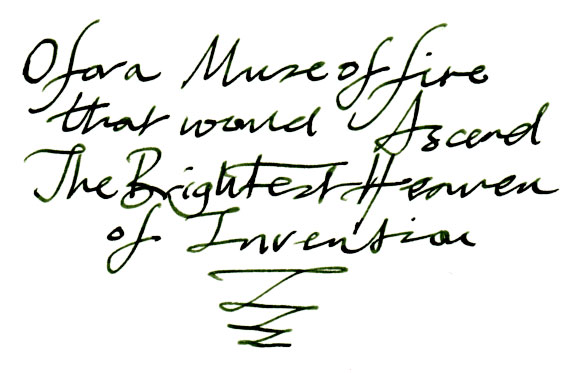
Montblanc British Racing Green
on W. H. Smith Quality Bond (white smooth bond paper).
I’d say that the ink flow with this nib is wet but well controlled.
It was slightly greater with the brown ink than the green, probably due
to the different characteristics of these inks. Papers used were smooth
bond: Moleskine Reporter’s Notebook (cream), W. H. Smith Quality
Bond (white), 80gsm plain white copier paper, and a cheap reporter’s
notepad (white, lined). No obvious problems with feathering or excessive
bleed through were seen with either ink and these papers. YMMV, as they
say.
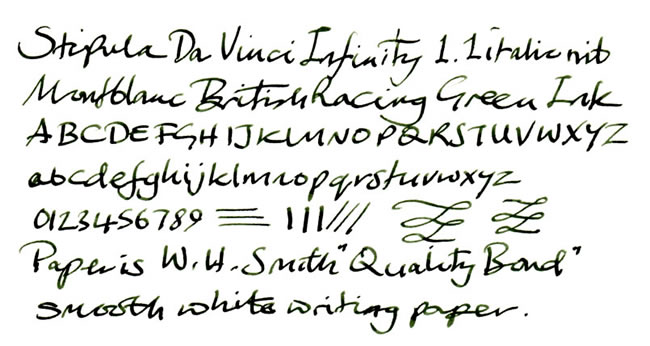
Montblanc British Racing Green
on W. H. Smith Quality Bond (white smooth bond paper).
Are there any issues with this pen? Some user reports have
said that the Da Vinci pens have a tendency to dry out, possibly because
the nib trap door is not airtight. That's certainly possible but I think
it would depend very much on the ink and the humidity and temperature
of the writer’s location (I live in the Midlands of England’s
“green and pleasant land”, not known for its arid conditions!).
I have left the pen with the trapdoor closed for as much as twelve hours
with a Havana Brown cartridge inserted, stored horizontally, and found
it to start up immediately without problems the next time I used it. What
I have found with Havana Brown is that the first few letters sometimes
appear darker after the pen has been left for some hours. This ink has
tended to do this sometimes in other pens in my experience (I have even
had it turn green in other pens!), and this may be a sign of evaporation.
However I have not found this to be a problem so far, and this has not
occurred with the British Racing Green via the converter, even overnight.
One other matter is the pocket clip, which I feel is more ornamental than
practical, as its tip is further away from the barrel than other such
clips, to avoid scraching the rotating barrel; this will significantly
lessen its effectiveness as a pocket clip.
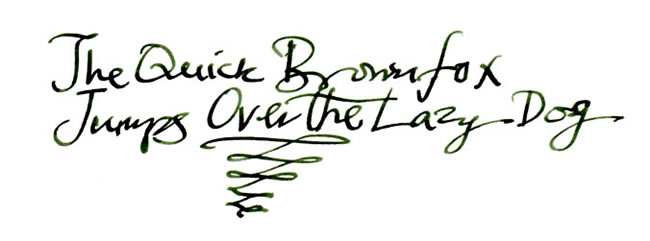
Montblanc British Racing Green
on a cheap smooth white lined Reporter’s notepad.
In conclusion, I feel this beautiful and fascinating pen is a real keeper,
and I certainly would not part with it. Other versions of the Da Vinci
obviously have slightly different characteristics dependent on the type
of material used to make the barrel (and there is a smaller version),
but the basic mechanism is much the same. The Infinity is nonethless unique,
as well a delight to use, and as a truly ‘Renaissance pen’
dedicated to the original ‘Renaissance man’, fills an essential
place in my themed collection.

Waterman Havana Brown on Moleskine
Reporter’s Notebook unlined cream bond paper - slightly thicker
than a standard Moleskine notebook.
All photos © Bill Riepl used by permission of Mr. Riepl.
Further information:
Original Stylophiles review:
http://www.stylophilesonline.com/09-05/09inf.htm
Glenn Marcus’s website – information on Stipula:
http://www.marcuslink.com/pens/stipula.html
Fountain Pen Domain website:
http://www.penseller.com/pages/stipula.htm
Acknowledgement:
Special thanks to Bill Riepl of Stylophiles for permission to use his
copyrighted photographs.
|